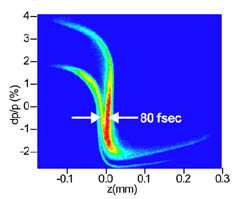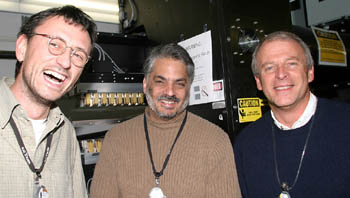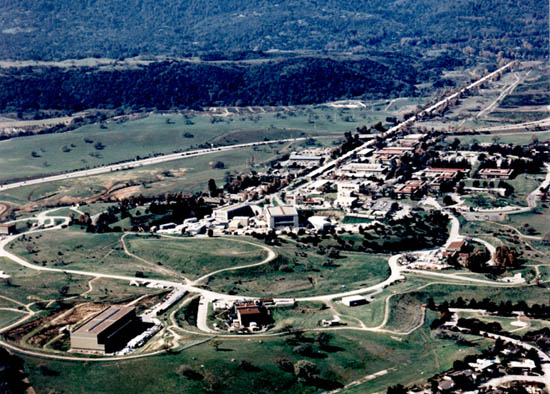 |
|
The Incredible Shortness of Bunches by Heather Rock Woods, SLAC Office of Public Affairs MENLO PARK, California—The world's longest linear accelerator has created the world's shortest bunches of electrons, which can be converted into bright, short pulses of x-rays to offer new views of the atomic world. These first-ever linac-produced x-rays, at Stanford Linear Accelerator Center, are 1,000 times shorter than those previously made by storage rings at SLAC, at Argonne National Laboratory and at other labs, to illuminate microscopic materials. "These ultra-short, very bright x-rays enable experimenters to make direct observations of atomic motion in matter that have never been seen before," said Jerry Hastings, assistant director of the Stanford Synchrotron Radiation Laboratory at SLAC, which Stanford manages for the U.S. Department of Energy. Scientists in the fields of chemistry, biology and materials science, from industry, universities and other labs, can use these x-rays to take instant pictures of simple chemical reactions in progress in solids and liquids.
SPPS compresses each bunch of about 21 billion electrons from 6 millimeters down to 12 microns (millionths of a meter). Traveling at the speed of light, the bunch whizzes past a fixed point in 80 femtoseconds (quadrillionths of a second). Packing more electrons together produces more current, producing brighter x-rays. The compressed bunches reach a peak current of 30 kiloAmperes—about 1,000 times greater than the current that flows through a household fuse. Manipulating the shape and size of electron bunches has become a science in itself. To compress the bunches, SPPS researchers rely on several tricks that can only be done at SLAC where the electrons pick up speed and energy— 28 billion electron volts—on their two-mile journey down the linac.
The gymnastics occur in three stages. First the bunches are compressed from 6 mm down to 1.2 mm in a curved section of the machine's injector, just before entering the linac. Electron bunches are usually accelerated through the linac atop radio frequency (RF) waves, similar to a surfboard riding the crest of an ocean wave. But in this first step, the bunches are adjusted to look like a surfer climbing a wave: the front of the bunch is closer to the top (and thus receives more RF energy) than the back. Going through the curved pipe, the low-energy tail takes the shortest path and catches up to the head, making the bunch shorter. The second step is similar. Farther down the linac, where they have been accelerated to 9 billion electron volts, the bunches are tipped to ride slightly ahead of the wave crest, so the rear gets accelerated more than the front. Entering a detour (or chicane) with four bends, this time the higher-energy tail takes the shortest path and catches up again, compressing the bunch to 50 microns. Accelerator physicist Paul Emma calculated just the right place to bend the beam to achieve this compression; as a result, the four-magnet chicane bend was installed last year. The final magnet design from engineer Cherrill Spencer surpassed tight tolerances to ensure that the new bending magnets would bend the beam without introducing optical aberrations. Linac engineer Lynn Bentson coordinated the surgical installation of the new 14-meter chicane. But in compressing the bunches to such a degree, the team ran into technical limits. "Packing billions of electrons into a short timeframe makes them radiate together," said Emma. These highly compressed bunches lose far more energy going through the bends than would a less dense bunch. The chicane magnets were delicately balanced to make long gentle bends that minimize the energy loss of coherent synchrotron radiation while still yielding bunch compression.
The final step exploits an effect previously considered a nuisance. As the electron bunches travel at the speed of light, they generate an electric wake, similar to the wake a boat makes, called a wakefield. But instead of spreading out and dissipating, the wake made by the head of the bunch bounces off the inside of the beam pipe and interferes with the tail. This interference creates another energy gradient between the head and tail, resulting in the final compression to 12 microns when the bunches travel through another small bend, in the Final Focus Test Beam (FFTB). At this point, the bunches can be wiggled by an undulator magnet in order to emit x-rays (from synchrotron radiation) for studying materials. Or the electrons can be used directly to study the accelerating properties of wakefields. Engineer Eric Bong installed the undulator, on loan from Argonne. SPPS will provide ultra-short, high-current pulses alternately to these two programs for the next two years. SPPS is an international collaboration that includes laboratory and university participants from the United States and abroad. SLAC is working closely with the Deutsches Elektronen Synchrotron (DESY) lab in Germany to develop instrumentation for tuning and optimizing the bunches. DESY is also planning a free electron laser similar to the LCLS. "We need a way to measure the bunch length, so part two of the project is inventing new technologies to measure on the sub-picosecond timescale," Krejcik said.
One technology is actually an old one: the group resuscitated a specialized accelerator cavity used at SLAC in the 1960's to kick the beam vertically. They inserted transverse deflecting cavity was into the beam line. When powered by a klystron, it samples a bunch by sweeping the bunch vertically across a screen where the vertical size gives a projection of bunch length after the second compression. The collaboration is developing electro-optic sampling techniques, borrowed from the world of fast laser technology, to measure the fully compressed bunches in the FFTB line. "We're starting with demonstration experiments now, and learning techniques that will be vital for exploiting LCLS. We're generating an ultra-fast community at SLAC, and stimulating interest in ultra-fast x-ray science internationally," said SSRL physicist John Arthur. "SPPS is relatively inexpensive." Emma said. "It uses the existing linac and it solves important problems, including making LCLS more plausible." On the Web: |
| last modified 11/25/2003 email Fermilab |
FRLsDFx9eyfrPXgV



